Click on portraits for full view.
Sometimes at the end of a day shooting “Spencer,” Kristen Stewart felt wrung out and absolutely exhausted. Other days, the weight of playing Princess Diana coming to terms with husband Prince Charles rejecting her, and the royal family dismissing her, left her angry. Sometimes she felt all alone. And some days, it was a combo platter, and Stewart was an absolute mess.
It didn’t matter how Stewart was feeling, though, because at the end of nearly every one of the 37 days she spent shooting “Spencer,” director Pablo Larraín had a final task for her to do before she left the set. For 30 minutes or so, Larraín would choose a musical cue — it might be Miles Davis or Frank Sinatra or Lou Reed — and Stewart, having picked out one of Diana’s dresses from a costume rack — would respond to the music. She didn’t know the song in advance. And usually, at least at the beginning, all Stewart wanted to do was talk about the song. Larraín would have to remind her that the camera was rolling.
When “Spencer” was finished shooting, Larrain took all the footage from these sessions and turned it into a 3½-minute montage that’s seen toward the end of the film, a wordless sequence set to composer Jonny Greenwood’s “Crucifix” that sums up a defiant Diana’s need to escape.
“You put these songs on and I’m f— swirling around in my conceived memories of what her life must have felt like, which was such a trip,” Stewart told Larraín on a recent October night. We’re up in the Hollywood Hills, Mt. Olympus to be precise, sitting on a patio overlooking a seemingly boundless blanket of Los Angeles lights, talking about our favorite scenes from Larraín’s sly, subversive and wholly subjective film.
“Responding to that music was like being alone in the bathroom singing songs and fantasizing about the guy that you want to hear your perspective and you imagine, ‘What if he had this vision of me here doing this?’ I just always fantasized about Diana, wondering, ‘What if there were cameras in there and Charles could see her exploring all these private moments?’”
“Spencer,” presented as a “fable from a true tragedy,” is filled with such private moments and also mystery. It was that ambiguity that interested Larraín in both Diana and the actress he cast to play her. Seated next to each other on an outdoor sofa, Stewart cupping a glass of red wine, Larraín scrolling through his phone to find playlists and photos, the two offered their spoiler-filled thoughts on some of the film’s indelible scenes.
Larraín says devising a shooting schedule is a “science.” On the first day of “Spencer,” it was all visuals, no words, an “embracing” day, Stewart says, like “settling into warm water.” The next day was different: A five-page scene with Diana arriving at the royal family’s chilly Sandringham country estate on Christmas Eve and being welcomed — perhaps processed is a better word — by Timothy Spall’s spectral Major Gregory, a military man tasked with making sure Diana doesn’t cause trouble. Larraín calls it an “arrival to an elegant prison.” Stewart is more blunt, calling it a “full-blown fight scene.”
“I’ve spent a lot of time in and out of the U.K. with British people,” Stewart says. “And I’ve always been a little bit slow on the uptake, because the quick, casual, disarming — what could be construed as catty — communication is just not my strong suit. I am a very stand-and-deliver, straight-up motherf—. But Diana was talented at it. It was embedded in her. She could turn passive-aggressive communication into an art form.”
That first meeting marks the beginning of a cat-and-mouse game that continues throughout “Spencer.” In her room, Diana finds a biography of Anne Boleyn, the wife Henry VIII beheaded. Soon, Diana begins seeing Boleyn’s ghost, listening to her advice at a crucial moment. “Anne Boleyn saved my life last night,” Diana tells a friend at the end of the film. Shortly afterward, we see Major Gregory return the Boleyn book to a shelf in the library.
So ... was Gregory Diana’s tutor or her tormentor?
“There’s a duality, so everyone’s right!” Stewart says. recalling an argument two guests in her home had the morning after the premiere. (She was eavesdropping.) One friend said Gregory was being helpful, leaving the book as a warning. The other friend found Gregory’s manner condemning and threatening.
Even Stewart and Larraín can’t agree about the character’s motivations — and Stewart finds this thrilling, as she loves a good debate. There’s an earlier scene in which Gregory tells Diana about a soldier who was spinning a tale about a wild horse that couldn’t be tamed and was hit by a bullet before he could finish the story. “I ask myself who do we soldiers die for?” Gregory says. “Then I remembered my oath. We all make an oath of loyalty to the crown.”
Larraín believes Gregory had Diana’s best interests in mind. Stewart is having none of it.
“He’s trying to connect to this girl and give her some advice and just say, ‘Hey, man, this is the structure, I believe in it. It’s not that hard once you give in.’ But it’s just so patronizing. Like, ‘Oh, did you just try and give voice to my life that you have never lived? Thank you for your very pretty metaphor. Thank you for likening me to a horse.’ I really hope my sarcasm in that scene comes across because I thought about that so, so much!”
Not everyone will appreciate Larraín’s unconventional approach. (“Good!” Stewart says when I bring this up.) But the scene in which Diana gathers her young sons, William and Harry, for an adorable, affecting Christmas Eve candlelight game of truth-telling figures to land with just about everyone, even those who don’t welcome a royal family story that’s spun into a Gothic nightmare. (References to Stanley Kubrick’s “The Shining” abound in “Spencer,” though Larraín says they were unintentional. “That movie is just in my bloodstream.”)
The family game-night scene was structured but not completely scripted, allowing Stewart and her co-stars (Jack Nielen plays Prince William; Freddie Spry is Prince Harry) the freedom to play and improvise. At one point, Harry asks William if he wants to be king. “I have no choice,” he answers. William then turns to Diana and inquires if she wants to be the queen. “I’ll be your mum. That’s my job.”
“None of that is scripted and I’m not saying that for kudos — even though, please rain them upon me,” Stewart says, laughing, “but because it’s very cool that everyone was so locked into the moment.”
Larraín pulls out his camera, showing a picture he took of them filming by candlelight. “It’s the only scene I shot with two cameras,” he says. Later in the film, there’s a scene in which Diana confides in her older son, William. Larraín reports that some people ask him why an adult would seek refuge in a 10-year-old child.
“I tell them I do it all the time,” Larraín says. “I have a 13-year-old daughter. There are boundaries, but she can be very helpful about a great many things!”
Stewart and Nielen, the 12-year-old English actor playing William, developed a relationship similar to the roles they played in “Spencer,” on-set confidantes who’d share secrets.
“He always loves to be the one person that really knew what was going on,” Stewart says. “And, by the way, he was not wrong. He was so perceptive, to the point where I was like, ‘Yo! Look away!’ Sometimes, he’d come up to me when I was down and ask, ‘Hey, are you OK?’ And I’d tell him, ‘Stop being so perceptive, little man!’
“It must be what it feels like to have a really beautiful relationship with your son, and you’re wanting to protect him from certain things that feel grown-up,” Stewart continues. “But at the same time, you want him to be your best friend, and you want to respect him and treat him like an adult because then he’ll act like an adult. Those are the types of kids that I really dig.”
Returning to that 3½-minute montage, which Larraín calls a “healing process for Diana,” and Stewart sees as a “by-the-skin-of-your-teeth resuscitation.” It arrives after Diana’s final encounter with Boleyn, in which the former queen of England urges her, “Go! Run!” Much of the sequence’s beauty and power comes from the fact that they shot it every day over the course of several weeks. “There was a different dress I wore every time we attempted the scene,” Stewart says.
Larraín opens his Spotify account and shares a 15-song playlist titled “Spencer dancing.” These are the songs he played as prompts for Stewart:
- “Perfect Day,” Scala & Kolacny Brothers, the cover of the Lou Reed song by a Belgian women’s choir, heard in the “Spencer” teaser trailer
- “All Apologies,” the Sinead O’Connor Nirvana cover
- “Générique,” Miles Davis
- “I’ve Got You Under My Skin,” Frank Sinatra, a song Stewart couldn’t keep a straight face through
- “Once in a Lifetime,” Talking Heads
- “Home,” LCD Soundsystem, per Stewart, the “best f— dance song of all time”
- “Laika,” Camel Power Club
- “Aria From ‘Goldberg Variations,’ BWV 988,” Johann Sebastian Bach, Gidon Kremer, Kremerata Baltica
- “Mi Mujer,” Nicolas Jaar
- “I Found a Reason,” Cat Power
- “Aria,” Balanescu Quartet
- “Concierto de Aranjuez: Adagio,” Miles Davis
- “Le temps de l’amour,” Françoise Hardy
- “Creep,” Scala & Kolacny Brothers
- “We’ll Meet Again,” Vera Lynn, a song heard at the end of Kubrick’s “Dr. Strangelove”
“Every single time one of those songs started, I would want to unpack it and talk about it,” Stewart says. “Like, ‘Oh man, I love this song’ or share my memories, but I had to save those digressions for later with my friends because Pablo was telling me, ‘We’re rolling.’ So I had to be this girl going f— crazy in this castle. And I was always exhausted because it was the end of the day.”
Larraín smiles. More than 20 years ago, he was working in his native Chile with Italian cinematographer Giuseppe Lanci, who told him, “There’s nothing better than a tired actor.” Meaning, that’s when they’re more accessible and sometimes vulnerable because their defenses are down. “I’m always more interested in accidents,” Larraín says. “And if you look at that montage, it’s filled with beautiful accidents, I think.
“It’s the ghost of cinema,” he adds later on in the evening, looking out at the city lights. “You’re never really doing what you think you’re doing.”

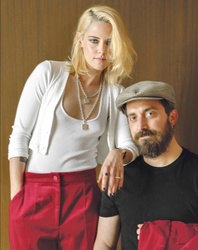
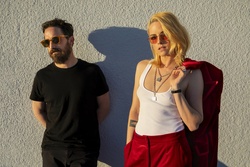
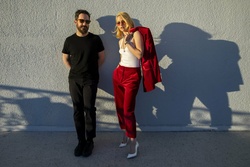
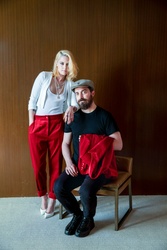



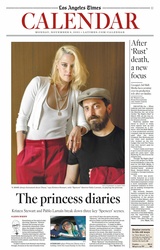
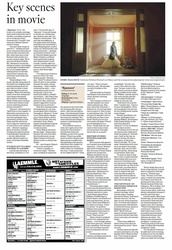
No comments:
Post a Comment
What do you think of this?